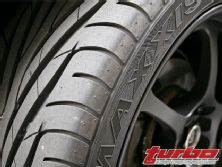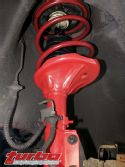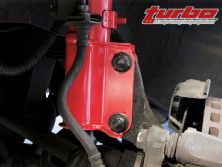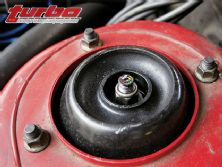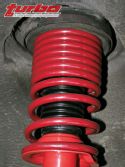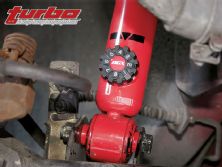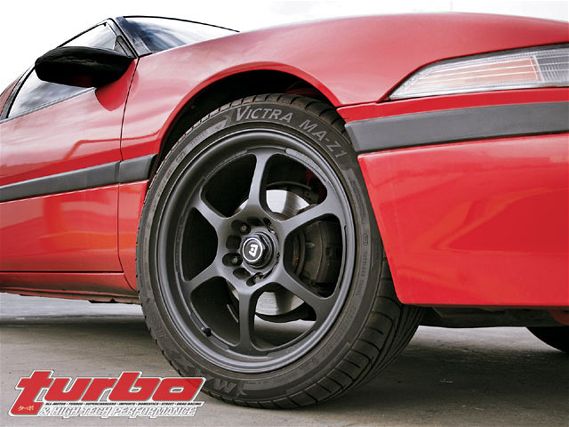 | One of the first things we did to Project Laser was fit a set of 17x8 Motegi Racing TRAKLITE 2.0's and 225/45-17 Maxxis Victra MA-ZI tires. We chose our tires first and then figured out what wheels and springs would accommodate them. We needed the TRAKLITE's +45 offset for everything to fit right.
| One of the first things we did to Project Laser was fit a set of 17x8 Motegi Racing TRAKLITE 2.0's and 225/45-17 Maxxis Victra MA-ZI tires. We chose our tires first and then figured out what wheels and springs would accommodate them. We needed the TRAKLITE's +45 offset for everything to fit right.
Most front-wheel-drive cars are plagued by understeer; some more than others. First generation Diamond Star owners know this. In stock form Project Laser exhibits some of the most classic displays of such poor handling characteristics. Now that our DSM's up and running, one of the first things we plan on doing is making it turn better.
Understeer happens while cornering, or when the car does everything it can to prevent the driver from cornering. Picture the car wanting to follow a straight line despite the curve ahead. It's the opposite of oversteer, but there's a more technical description for it. This handling flaw occurs when the front tires break away first in a corner. This pushing sensation happens since the front tires have a larger slip angle than the rear. The slip angle is the difference in degrees between the direction the wheel is traveling and the direction of the tire's tread caused by flex. In other words: it's the difference between the direction the wheel is pointed and the circle or trajectory the wheel is trying to track. This makes it difficult to steer into tight and/or high-speed turns. Most OEM's outfit their front-wheel-drive cars with understeer built in, since it's generally safer for inexperienced drivers in the event of a massive direction change. It just really sucks for the rest of us. Often times all you have to do to correct an out of control car with built-in understeer is let off the gas - good for the noob, bad for us. Oversteer requires steering manipulation, i.e., skill.
Reducing understeer isn't hard, but it's easy to screw things up in the process. A careful balance between what's done to the front of the car versus the rear must be taken. There are many things that affect steering characteristics: tires and wheels; struts, shocks and springs; even weight and aerodynamics. The first place to go looking for handling improvements should be the tires - the most important part of your car's suspension. Stuffing the widest tire possible into the wheelwell, and then fitting dampers and lowering springs around it, will get you the best results. To ensure the widest tire is chosen, careful measurements need to be taken. The easiest way to do this is to measure the clearance between the existing tire's inner sidewall and the closest thing it will hit, like a strut housing. Add to that half of the new tire's extra width and see what fits. Keep in mind though that just because a tire's advertised at 225mm wide, it might vary so check with the manufacturer first. Wheels with a reduced offset will space the tire out farther, allowing for its extra width. This is a careful balance though, since offset can disturb handling too and make a good car look stupid.
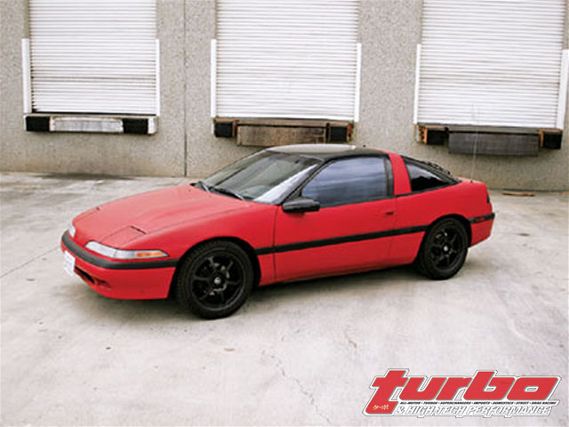 | Project: Laser - Project Car
| Project: Laser - Project Car
This is what we did with Project Laser - not make it look stupid, but put wider tires on it through reduced wheel offset. One of the first things we did was contact Maxxis for a set of 225/45-17 Z-rated tires. This is the widest tire we could fit and still be able to lower the chassis with stiffer springs. The MA-Z1 Victra is Maxxis' newest high-performance, directional tire and, so far, we couldn't be happier with them. Besides using stickier, wider tires, tire pressure plays a role in understeer management. Slightly higher pressure in the front as opposed to the rear (about 5 psi) can change slip angle characteristics. Larger tire section widths and aspect ratios in the front can also reduce understeer but will make a car like our DSM look funny, so we skipped that and put the same size all around. Once we picked out our tires the next thing we needed were some 8-inch-wide wheels to mount them on. We wanted something light to avoid the penalties of poor acceleration, turning and braking associated with heavier wheels' exponentially larger rotating mass. But we want larger calipers in the future, so 15's were out of the question. Instead we chose 17x8 Motegi Racing TRAKLITE 2.0's for this. The lightweight, Teflon-coated wheels have a +45 offset, which allows us to run the wider tires we wanted without hitting things like strut housings. They're also only 14 pounds each. It's all about timing and combination. If we chose our wheels first without considering offset, we wouldn't have enough clearance for the 225 tires. Handling was improved quite a bit just from the wheels and tires. Our Laser still had a tendency to roll around corners but our traction limit increased significantly.
Next, we started looking for dampers and springs. The first-generation DSM is old. With that in mind, we knew that finding suspension components would be challenging. We had two choices: install a coilover setup that would give us the dampening and ride-height adjustability we wanted or a more conventional damper and spring package that lacks adjustability but costs much less. The choice was made for us since there are only a couple of companies we know of that make coilovers for our vehicle. Both are exceptional systems that will give us the adjustability we need but cost several times more than what the DSM is worth. We decided to go with the more economical KYB AGX dampers and Eibach Sportline springs. We don't regret it. Like more expensive coilovers, the AGX dampers also have adjustable valving: four-way in the front and eight-way in the rear. This comes in handy when tuning out understeer. Typically, softening the front and stiffening the rear will improve handling and promote a bit of oversteer. The AGX's let us do this, but we're still dialing in that perfect setting. About the only thing we're missing from an adjustable coilover suspension is ride-height flexibility. We don't miss the ability to raise or lower our Laser for aesthetic reasons though. Coilovers have the ability to transfer weight over different corners of the vehicle based on individual coil height. Reducing weight over the front and increasing it in the rear is an easy way to ward off understeer. To make matters worse, we still plan on adding a front-mount intercooler and a few other pieces under the hood, which will only make things heavier up front. Of course, we won't be adding any weight out back either. So much for that. Another reason why we like the KYB's: unlike coilovers, the KYB struts are similar in size and shape to the OEM ones, which means we don't have to make any further offset changes based on coilover clearances.
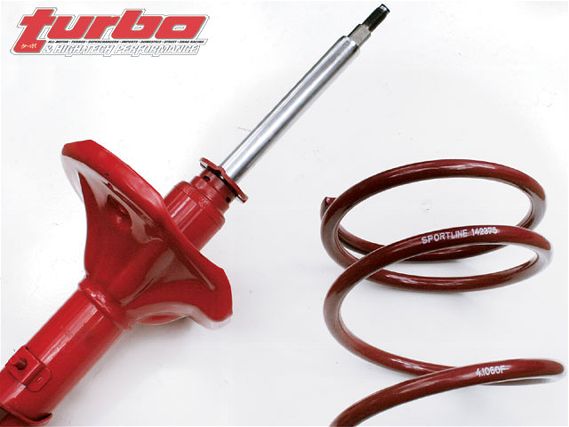 | Project: Laser - Project Car
| Project: Laser - Project Car
We fit Eibach Sportline lowering springs with a 1.5-inch drop around the KYB dampers. The conservative ride height allows plenty of room for our Maxxis tires without any scraping, rubbing or fender rolling. The spring rate bias is softer in the front, which also helps prevent excessive understeer and distributes the weight more favorably. Camber moves in a negative direction when a vehicle is lowered so we corrected everything with an Eibach camber adjustment kit. Negative camber is actually a good thing though, where understeer is concerned. But too much of it will destroy a set of tires faster than we can afford, so it's all about compromise. If we were setting up our DSM for full-time track use, we also might even try running a bit of positive camber in the back and toe out the front wheels slightly. We'll test some of these settings at a future track day or when we have an extra set of tires.
In addition to replacing a couple of damaged ball joints and worn bushings, there're still improvements to be found with Project Laser's suspension. In an effort to further reduce understeer, we'll be looking into antiroll bars and replacing our bushings with stiffer pieces from Energy Suspension. But for now we're quite pleased with our KYB/Eibach combination. First-generation DSM's aren't exactly the best handling cars to begin with. With that in mind, we've got to believe things can only get better.

